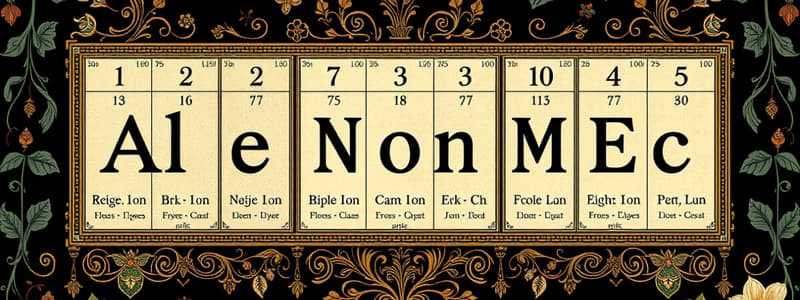Podcast
Questions and Answers
Which of the following reactions generates sulfur dioxide gas?
Which of the following reactions generates sulfur dioxide gas?
- Cu + 2H2SO4 -> CuSO4 + SO2 + 2H2O (correct)
- C + 2H2SO4 -> CO2 + 2H2O + 2SO2 (correct)
- Mg + 2HCI -> MgCl2 + H2
- Zn + H2SO4 -> ZnSO4 + H2
Which statement correctly describes the reactivity of non-metals with acids?
Which statement correctly describes the reactivity of non-metals with acids?
- Non-metals produce hydrogen gas when reacting with acids.
- Non-metals react vigorously with all types of acids.
- Non-metals generally do not react with any acids.
- Only carbon and sulfur react with concentrated sulfuric acid. (correct)
What is a characteristic property of metalloids?
What is a characteristic property of metalloids?
- They are highly conductive at all temperatures.
- They are located only on the left side of the periodic table.
- They exhibit properties of both metals and non-metals. (correct)
- They react aggressively with acids and bases.
Which metal does not liberate sulfur dioxide when reacting with hot concentrated sulfuric acid?
Which metal does not liberate sulfur dioxide when reacting with hot concentrated sulfuric acid?
Which of the following metalloids is known for its good conductivity at elevated temperatures?
Which of the following metalloids is known for its good conductivity at elevated temperatures?
Which of the following reactions illustrates a base-induced reaction involving metals?
Which of the following reactions illustrates a base-induced reaction involving metals?
What defines the location of metalloids on the periodic table?
What defines the location of metalloids on the periodic table?
Which of the following compounds is formed when aluminum reacts with concentrated bases?
Which of the following compounds is formed when aluminum reacts with concentrated bases?
Which non-metal does not typically react with acids?
Which non-metal does not typically react with acids?
What happens to the conductivity of metalloids with an increase in temperature?
What happens to the conductivity of metalloids with an increase in temperature?
Flashcards are hidden until you start studying
Study Notes
Classification of Elements
- Elements are classified as metals, non-metals, and metalloids, based on various properties.
Properties of Metals
- Generally solid at room temperature, with exceptions like mercury (Hg) and gallium (Ga) being liquids.
- High melting and boiling points, though sodium (Na), potassium (K), and mercury (Hg) have lower points.
- Typically hard, but exceptions include sodium (Na) and potassium (K), which are soft.
- High density, except for lithium (Li), sodium (Na), and potassium (K), which are less dense than water.
- Good conductors of heat and electricity; exceptions include bismuth (Bi) and tungsten (W).
- Possess lustre, giving metallic shine.
- High tensile strength, although zinc (Zn) has very low tensile strength.
- Generally malleable and ductile, with zinc being an exception.
- Sonorous, producing a ringing sound when struck.
- Found primarily in combined states, with noble metals being the exception occurring in free state.
Properties of Non-Metals
- Mostly gaseous at room temperature, with solids like carbon (C), sulfur (S), phosphorus (P), iodine (I2), and bromine (Br) existing in various states.
- Characterized by low melting and boiling points; exceptions include carbon (C), silicon (Si), and boron (B).
- Solid non-metals are generally brittle, with diamond being the hardest naturally occurring substance.
- Low density in general, with diamond being an exception.
- Poor conductors of heat and electricity; graphite and gas carbon act as good conductors.
- Lack lustre, although iodine (I2) and graphite have some.
- Non-malleable and non-ductile, except for ductile carbon fibers.
- Non-sonorous.
- Found in both free and combined states.
Valence Electrons and Ionic Formation
- Metals contain 1 to 3 electrons in their valence shells, allowing them to lose electrons and form stable cations.
- Non-metals have 4 to 7 electrons in their valence shells, typically gaining electrons to form stable anions.
Reactions with Oxygen
- Metals react with oxygen to form basic metal oxides, which turn red litmus blue.
- Non-metals form acidic oxides, turning blue litmus red.
- Examples: Sodium (Na) and potassium (K) react vigorously with oxygen; carbon (C) and sulfur (S) produce carbon dioxide and sulfur dioxide, respectively.
Reactions with Water
- Potassium and sodium react vigorously with cold water, producing alkali solutions and hydrogen gas.
- Most non-metals do not react with water; exceptions include carbon producing water gas when reacted with steam.
Reactions with Acids
- Active metals (like Mg and Zn) react with dilute hydrochloric acid (HCl) and sulfuric acid (H2SO4), releasing hydrogen gas.
- Very few non-metals react with acids; sulfur (S) and carbon (C) exhibit reactions with concentrated sulfuric acid.
Reactions with Bases
- Metals such as aluminium (Al) and zinc (Zn) react with concentrated bases to produce hydrogen gas.
- Non-metal reactivity with bases is more complex and less common.
Metalloids
- Exhibit properties of both metals and non-metals.
- Notable metalloids include germanium, arsenic, antimony, selenium, and tellurium, each possessing unique conductive and chemical properties.
Location in the Periodic Table
- Metals are predominantly on the left side, non-metals are on the right, and metalloids are situated in a staircase pattern between them.
Studying That Suits You
Use AI to generate personalized quizzes and flashcards to suit your learning preferences.




